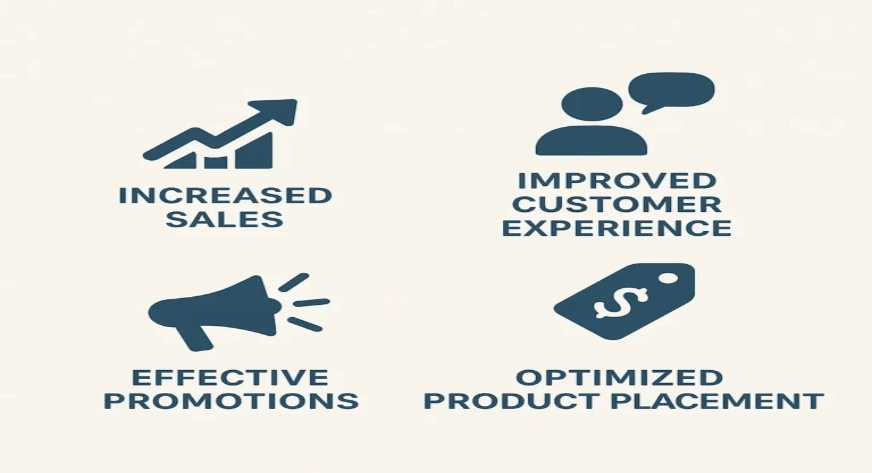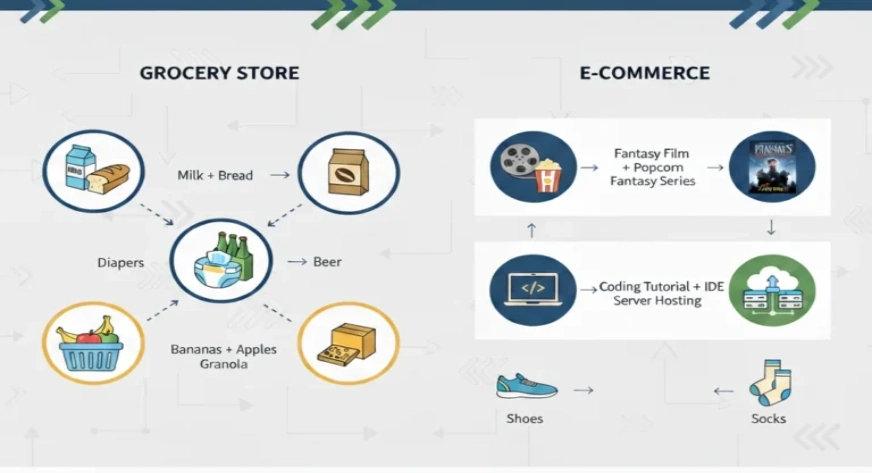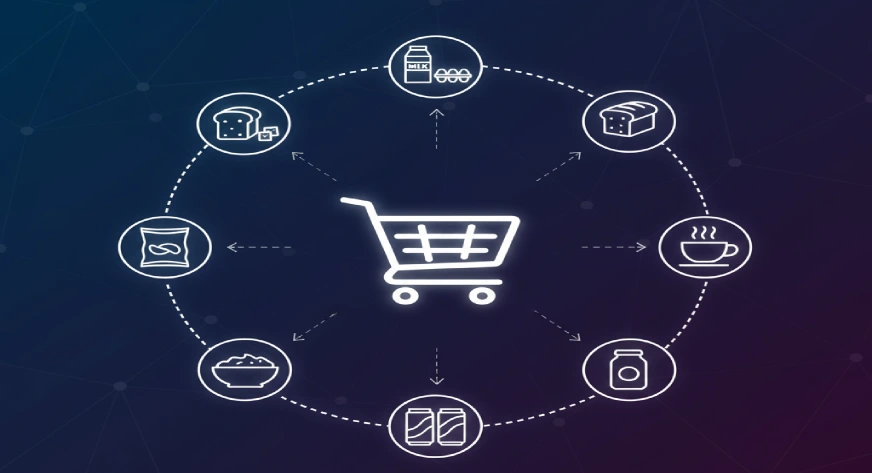Market Basket Analysis is a data-mining technique used to find patterns of items that are frequently bought together, helping businesses understand customer buying habits and improve product placement, cross-selling, and promotions.
It is a simple yet powerful way businesses understand what customers like to buy together. It looks at shopping patterns and finds connections between products. For example, if many people buy bread and butter together, the store can place them side by side or offer bundle discounts. This method helps businesses increase sales, create better promotions, and make shopping easier for customers. In this article, we’ll explore how market basket analysis works, why it matters, and where you’ve already seen it in action without even realizing.
How Does Market Basket Analysis Work?
The main idea behind market basket analysis is to study large amounts of transaction data and see which products often appear together. This is done through association rules.
For instance, a rule may look like this: “If a customer buys milk, there’s a 70% chance they will also buy cereal.These patterns come from analyzing thousands of past purchases.
The process usually involves three steps:
- Collecting data – From customer receipts, online orders, or loyalty cards.
- Finding patterns – Using algorithms to detect which items are purchased together often.
- Creating rules – Turning those patterns into insights businesses can use.
A simple supermarket example would be placing chips near cold drinks because many people tend to buy them together for parties.
Also Read , 10 Top Digital Marketing Agencies in the World
Benefits of Market Basket Analysis

Using market basket analysis has several advantages that go beyond just selling more.
- Smarter cross-selling and upselling: Recommending products that naturally pair together, like pasta and pasta sauce, encourages customers to buy more.
- Better store layout and design: Retailers can arrange shelves so that commonly bought items are easy to find together.
- Improved online shopping experience: E-commerce platforms can suggest “Frequently Bought Together” items, saving customers time.
- Optimized promotions: Discounts can be designed around product bundles instead of individual items, making offers more attractive.
Customer satisfaction: Shoppers enjoy a smoother, more personalized experience when suggestions feel relevant.
Market Basket Analysis Example

Market basket analysis is not just theory, it’s something you’ve likely seen and interacted with in your everyday life. Let’s break down a few common examples where it works behind the scenes:
- Amazon’s “Frequently Bought Together
One of the most famous applications of market basket analysis is on Amazon. When you add a laptop to your cart, the site instantly suggests items like a laptop bag, mouse, or external hard drive. This isn’t random—it’s based on purchase data from millions of shoppers. By showing these combinations, Amazon increases order value while making shopping easier for customers.
- Supermarket Shelf Placement
Ever noticed bread, butter, and jam arranged close together? That’s market basket analysis in action. Retailers place products with strong purchase links side by side, so customers are more likely to pick them up together. It’s a subtle way of driving higher sales without aggressive promotion.
- Restaurant Combos
Would you like fries with that?” is the simplest example of cross-selling powered by market basket thinking. Restaurants know fries and drinks are often ordered with burgers, so they package them as combos to increase both sales and customer satisfaction.
- Fashion E-Commerce Suggestions
Online clothing stores often recommend accessories, shoes, or bags to pair with a dress in your cart. This is another form of market basket analysis—it makes the shopping experience more complete and also increases the store’s revenue per order.
- Streaming Platforms
Even entertainment services like Netflix or Spotify use similar principles. They recommend movies or songs that are often “consumed together,” tailoring user experiences while keeping engagement high.
These real-world cases show how versatile market basket analysis is. It’s not limited to one sector—it works anywhere customers make choices involving multiple products or services.
Also Read , 10 Ways to Use in AI Iin Digital Marketing
Challenges of Market Basket Analysis
While market basket analysis is effective, there are different challenges
- Data Quality Issues – If transcation data is incomplete or inaccurate, insights wont be reliable.
- Too Many Rules – Sometimes, the system produces thousands of possible item combinations, making it hard to focus on what matters.
- Changing Behavior – Customer preferences can shift due to seasons, festivals, or new product launches.
- Over-Reliance on History – Past data doesn’t always predict future buying patterns, especially in industries where trends change quickly.
Best Practices for Using Market Basket Analysis
To make market basket analysis effective, businesses need to go beyond just spotting patterns. Here are some practical tips:
- Keep Your Data Fresh
Customer preferences change quickly. What sold together last year may not be popular today. Regularly updating data ensures that your product suggestions remain relevant and useful.
- Start Small and Test
Instead of rolling out dozens of product bundles at once, start with a few proven combinations. For example, a grocery store could test offering discounts on coffee + cookies before trying larger campaigns. This reduces risk and makes results easier to measure.
- Match Insights with Seasons and Trends
Data might show chocolates and flowers sell well together—but demand peaks around Valentine’s Day. Combine analytical insights with seasonal behavior to get the best results. This keeps offers timely and more appealing.
- Use Clear, Customer-Friendly Suggestions
Don’t overwhelm customers with too many recommendations at once. A simple “Frequently Bought Together” or “You Might Like” works better than a long list. It should feel like helpful advice, not aggressive selling.
- Monitor Results and Refine
Market basket analysis is most effective when businesses track outcomes. Did a new combo increase sales? Did customers respond well to the suggestions? By measuring results and refining strategies, companies can continuously improve.
- Think Beyond Retail
Don’t limit the practice to traditional shopping. Banks, telecom providers, and even healthcare services can use it. For example, a telecom brand could bundle internet packs with OTT subscriptions if data shows customers often purchase both.
By applying these best practices, businesses can use market basket analysis not just to push products, but to genuinely improve customer experience while driving sustainable growth.
Wrapping Up
Market basket analysis is all about understanding the hidden connections in customer purchases. From supermarkets pairing chips with cold drinks to Amazon showing “Frequently Bought Together” items, it helps businesses boost sales while making life easier for shoppers. By applying the right techniques and keeping data updated, market basket analysis can turn everyday shopping patterns into smart strategies that work for both businesses and customers.
At WebWorks Co., we believe data is more than numbers—it’s a way to understand people. That’s why our digital marketing services are designed to help brands connect with the right audience at the right time. By combining smart strategies with insights like market basket analysis, we help businesses grow while keeping customers at the center of everything.
Frequently Asked Questions
Q1. Can AI do a Market Analysis?
Yes, AI can analyze market trends, customer behavior, and large datasets to provide insights and accurate forecasts.
Q2. What is Market Basket analysis in machine learning?
Market Basket Analysis in machine learning is an unsupervised learning technique that identifies associations or patterns between items frequently purchased together, using algorithms like Apriori or FP-Growth to generate association rules for recommendations and cross-selling.




